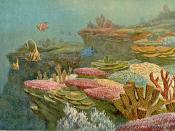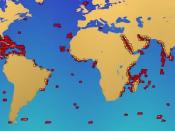Description of each biome . . .
Tropical rainforests are hot moist communities often located close to the equator. Tropical Rainforests receive anywhere from 60 to 160 inches of rain during the year. There warm climate and humid weather house a diverse group of plants and animals. There are over fifteen million different plants and animals in this environment.
Deserts of consist of dry arid land that receives little to no rainfall each year. There are many types of deserts. Some like the Sahara desert are extremely hot while the Takla Makan is rather cold. Deserts are often perceived as vast regions of sand. Some deserts are made up of mountains and rocky cliffs. Temperatures during the day are very high but as the moon rises there is a sudden drop in temperature. All of these factors make it very difficult to survive in a desert climate.
Taiga experiences cold winters and cool summers.
There is a good amount of rain. During their long winters Taiga often receives snowfall. The Taiga area stretches across the northern hemisphere. They are evergreen trees, shrubs, and forbs growing all over this biome. Bogs are often formed after it rains due to the deep depressions in the ground from glaciers of the past.
The tundra is the simplest biome in terms of species composition and food chains. There is a low temperature and very little biotic diversity. Tundra's have short seasons of growth and reproduction. Energy and nutrients are in the form of dead organic materials.
Located mostly in Africa, the Savannahs consist mostly of tall grasses and few trees. There is a dry season and a wet season in Savannahs. Large animals can turn a forest into a Savannah by smooshing the vegetation in a particular area.
Grasslands are large areas with rolling...


